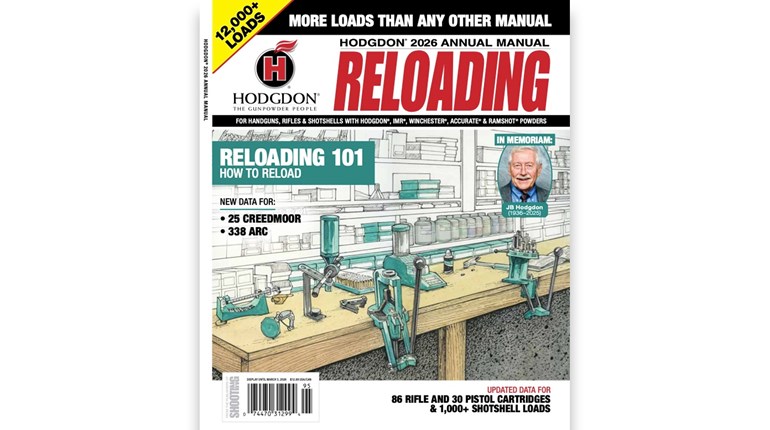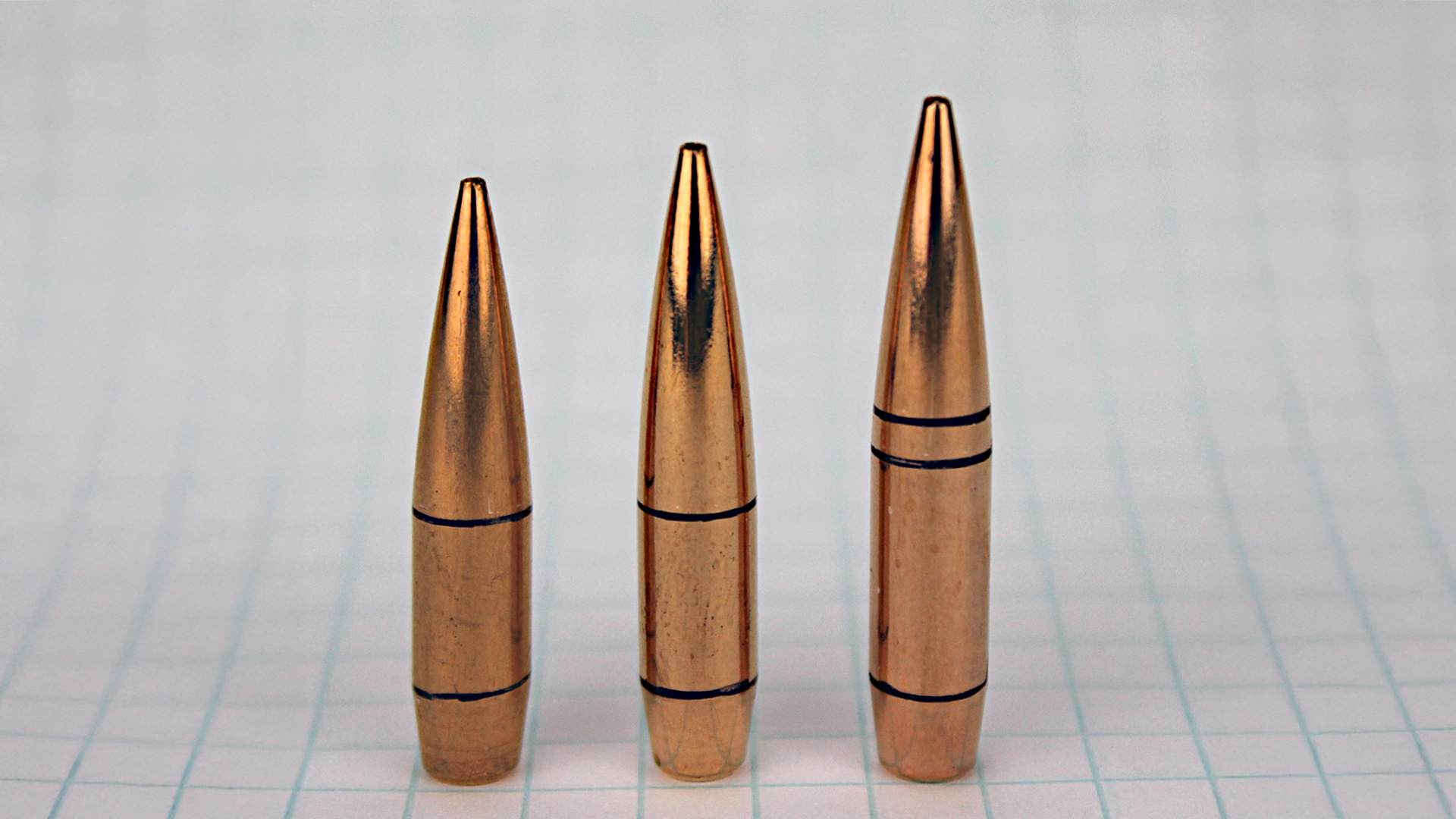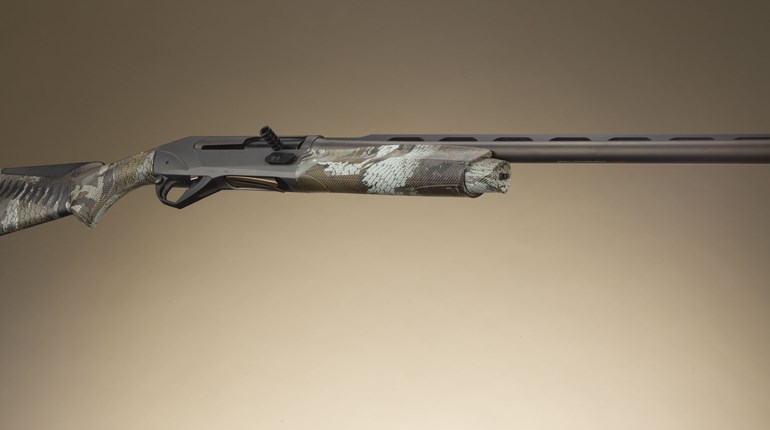
We’ve got three basic choices in labor saving machines that clean mass quantities of cases at one go: the vibratory dry media tumbler, the ultrasonic cleaner and the stainless steel pin/liquid media rotary tumbler. Each has its own benefits and negatives; only you can match the method to your particular priorities and proclivities to decide which is best for you. What are those positives and negatives?
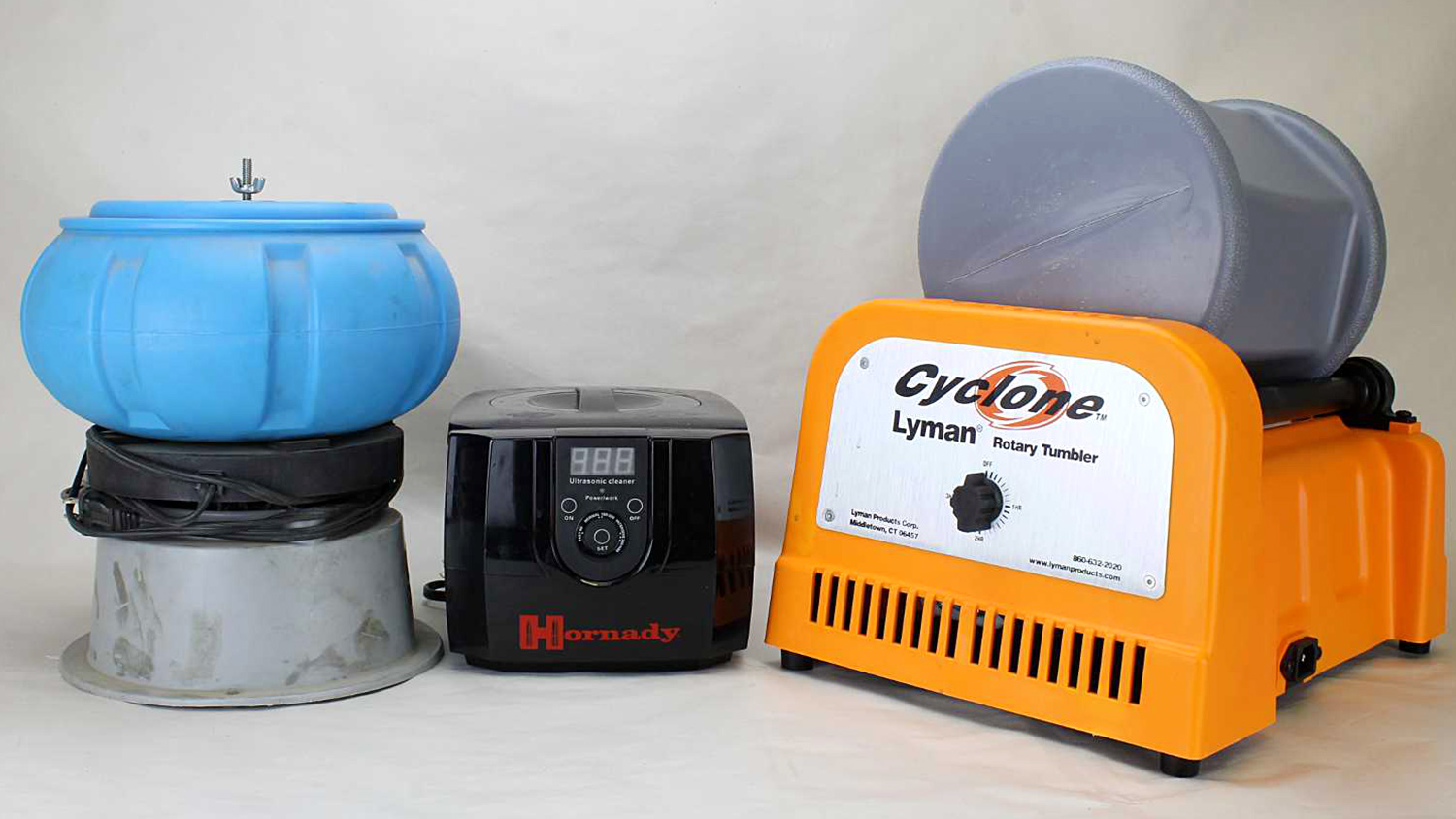
Dry vibrate
The vibratory tumbler is the most popular cleaning method. The tumbler is essentially a plastic tub that sits atop an electric motor that causes it to vibrate. Anything inside the tub―in our case, brass and dry media―vibrates along with it. The vibratory tumbler, of necessity, is a bit loud; most folks run theirs out of earshot, in the garage.
The polishing media is ground corn cob or walnut shell. We pour dry media into the tub, toss in our dirty brass, turn the motor on and walk away for a few hours. When we come back, our brass looks nice and shiny. Now we pour the tub contents into a sieve/sifter over a bucket to separate media from brass. Turn each case upside down and tap it to dump out the media that gets caught inside. Wipe the media dust from the outside of each case and we’re done.
Dry media needs occasional replacement; how often depends on how hard we work it. As the media particles vibrate against each other they break down into dust. That dust is one of the drawbacks of the dry media method; it’s remarkably dirty and sticks to everything. To keep it in check we have to wipe out the tub while its contents are in the bucket. Eventually we have to toss the worn-out media.
We can add an ammonia-based liquid to increase the media’s polishing power before each tumbling session. The ammonia reacts with the copper in the brass, so its polishing effect is actually chemical, not mechanical. We might instead add jeweler’s rouge, an abrasive like the media; in fact, we can buy dry media with the rouge already in it. Be aware, however, that rouge is a very fine powder that can stick to the inner walls of cases, so use it sparingly. While shooting rouge down the bore probably doesn’t hurt it, the rouge won’t polish the bore either and it may contribute to fouling. I’m not aware of anyone who’s done a study of that―you can be the first.
Size does matter
Vibratory tumblers, like people, come in various sizes and have their limits. For tumblers, those limits are how many cases they can clean at a time. Because cartridge cases also come in various sizes, we see tumbler capacities described as “1000 9 mm cases” or maybe “100 .308 cases,” references we can visualize on a pragmatic level much better than, “40 cubic inches.” Generally however, the more cases we add to our tumbler, the longer it takes to clean them.
Be careful when mixing different cartridge brass together in a tumbler, as the media can cause a smaller case to become tightly wedged inside a larger one―9 mm Luger and .45 ACP, for example, can be harder to pry apart than two teenagers in love.
Note that tumblers will not cure case corrosion, though they may somewhat smooth a roughened corroded brass surface. Dry media tumblers also won’t clean primer pockets, even if you knock the primers out before tumbling. Another type of cleaner has that advantage over dry media.
Wet and quiet
Ultrasonic cleaners work somewhat like vibratory dry media tumblers, but also nothing like them at all. Both types utilize a media and vibration, but the ultrasonic cleaner media is liquid and vibration occurs at nearly a microscopic level. Comparing it to dishwashing, we can think of the liquid media as a kind of soap and water while the ultrasonic part causes waves to act as scrubbers loosening and lifting away crud. And while it works well for cleaning, unlike dry media tumblers, ultrasonic cleaners do not polish brass, so it comes out clean but dull (perhaps some liquid solutions shine better than others). Ultrasonic cleaners can, however, clean the insides of cases.
Ultrasonic cleaners come in a variety of sizes, too, with prices quickly escalating with capacity. Each maker markets their own flavor of cleaning solution, which is typically mixed with water at a ratio of about 40:1; because batches are reusable several times over, a little goes a long way. Unlike dry media tumblers, ultrasonic cleaners do the job in minutes rather than hours, and except for a quiet buzzing, silently, too. Also unlike dry media tumblers, the ultrasonics may clean primer pockets to some degree if we punch the primers out first with a universal decapper. Ultrasonic cleaners come with removable baskets to lift out the brass; we pour the media into a plastic container to reuse until exhausted (strain it through a cloth to remove particulates) and wipe out the inside of the cleaner’s tub. Done.
Ultrasonic cleaners have a big advantage over tumblers in that they’re great for quickly cleaning gun parts. If this double duty is your intent and you’ve got the coinage, skip over the smallest one-quart ultrasonic cleaners and go for bigger ones that can hold an entire pistol frame. Steel requires a cleaning solution different from that used for brass; both solutions, of course, are available from the manufacturer.
Here’s a good place to mention that you can find online a million posts from guys who have developed their own ersatz ultrasonic brass cleaning solution, which usually include some combination of water, dish soap, lemon juice (citric acid), vinegar (acetic acid), ammonia and maybe some voodoo.
Drum and pins
Dry media vibratory tumblers have been around for decades, affordable ultrasonic cleaners for a few years. Rotary tumblers have been around a long time too, but what’s new for handloaders is the addition of tiny stainless steel pins and a liquid solution for cleaning brass cartridge cases.
Rotary tumblers are hollow drums laid on their sides and turned by electrically powered rollers. The pins and cases go inside the drum; we add that 40:1 solution to just cover everything, twist the cap on tightly, and then walk away from it for one to three hours while it does its thing. This system does it all: it cleans the outside and inside of cases, it cleans primer pockets and it polishes―and it does it in way less time and with slightly less noise than dry media tumblers.
After tumbling, place the two provided pin and brass sifters over a bucket or sink (to accept the liquid media) and dump the drum’s contents into the sifters. Knock the pins out of the cases and scrape the stragglers out of the drum, then spread the pins out to dry. The liquid media turns blacker than an overdue oil change and is not reusable.
New brass from old
For this article I ran some really nasty, corroded .308 Winchester range brass (picture at top) through all three types of cleaners, a Midway-brand vibratory, a Hornady ultrasonic and a Lyman Cyclone rotary. Note: this test in no way compares one manufacturer against another; rather, it tests only the cleaning methods.
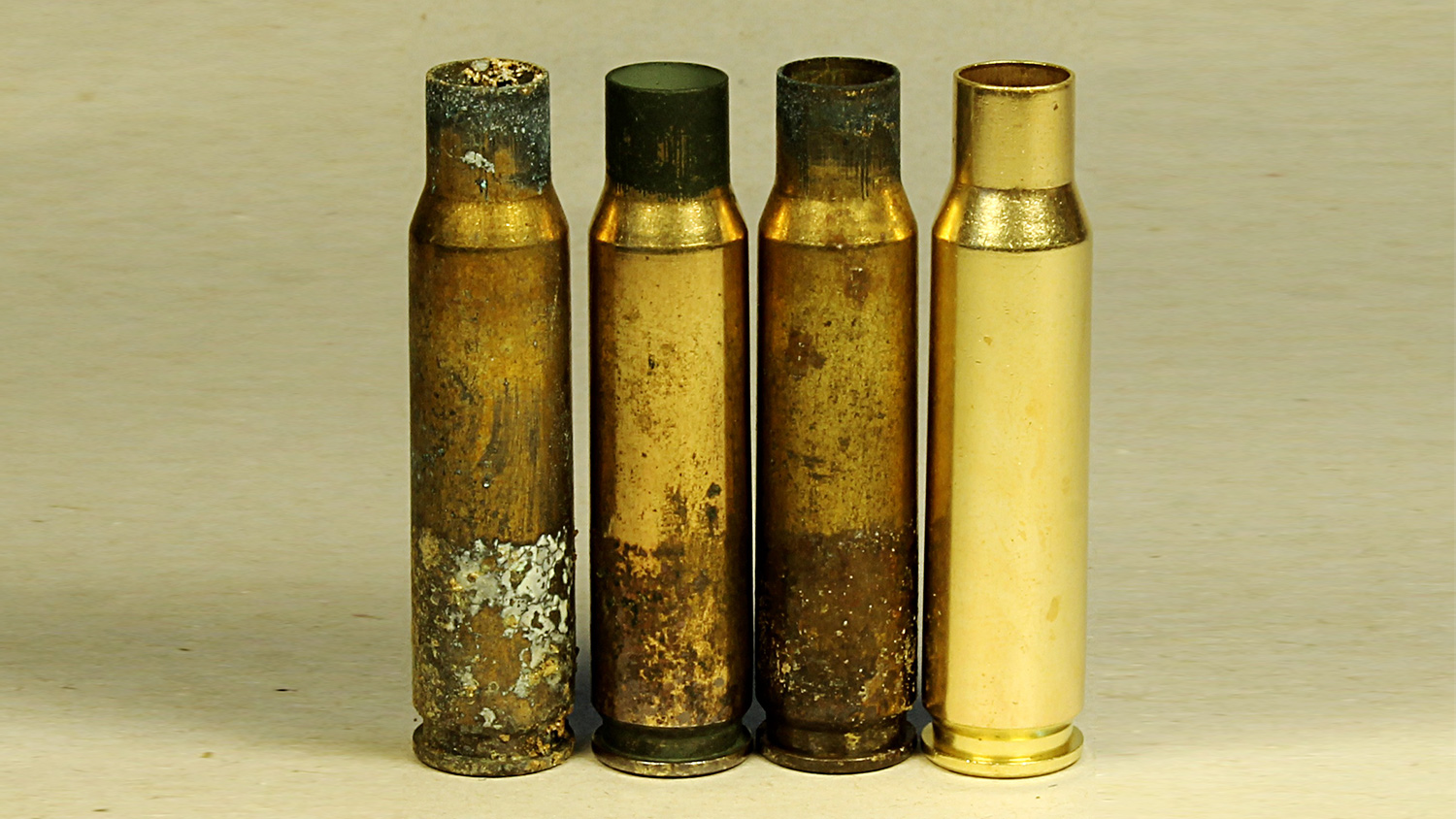
I put the ultrasonic cleaner through the recommended three eight-minute cycles. It cleaned the cruddy cases inside and out, but did not clean the primer pockets to any significant degree. Also―no surprise, really―it didn’t effectively address the corrosion.
Two hours of dry media vibratory cleaning seemed to go after the corrosion better than the ultrasonic, and it cleaned and polished the bare brass areas but, as expected, case interiors and primer pockets look untouched.
After the recommended two hours of rotary tumbling for very dirty brass, the nasty cases came out looking almost brand new. Though not 100 percent perfectly cleaned, primer pockets are clean enough that further scraping is unnecessary.
Conclusion
Dry media vibratory tumblers have the cost advantage, with small models starting below $60. Dry media goes for around $1-$2 per pound; sold typically in eight-pound containers, one purchase of dry media can last for years. Downsides: sticky dust, and they don’t clean primer pockets or case interiors.
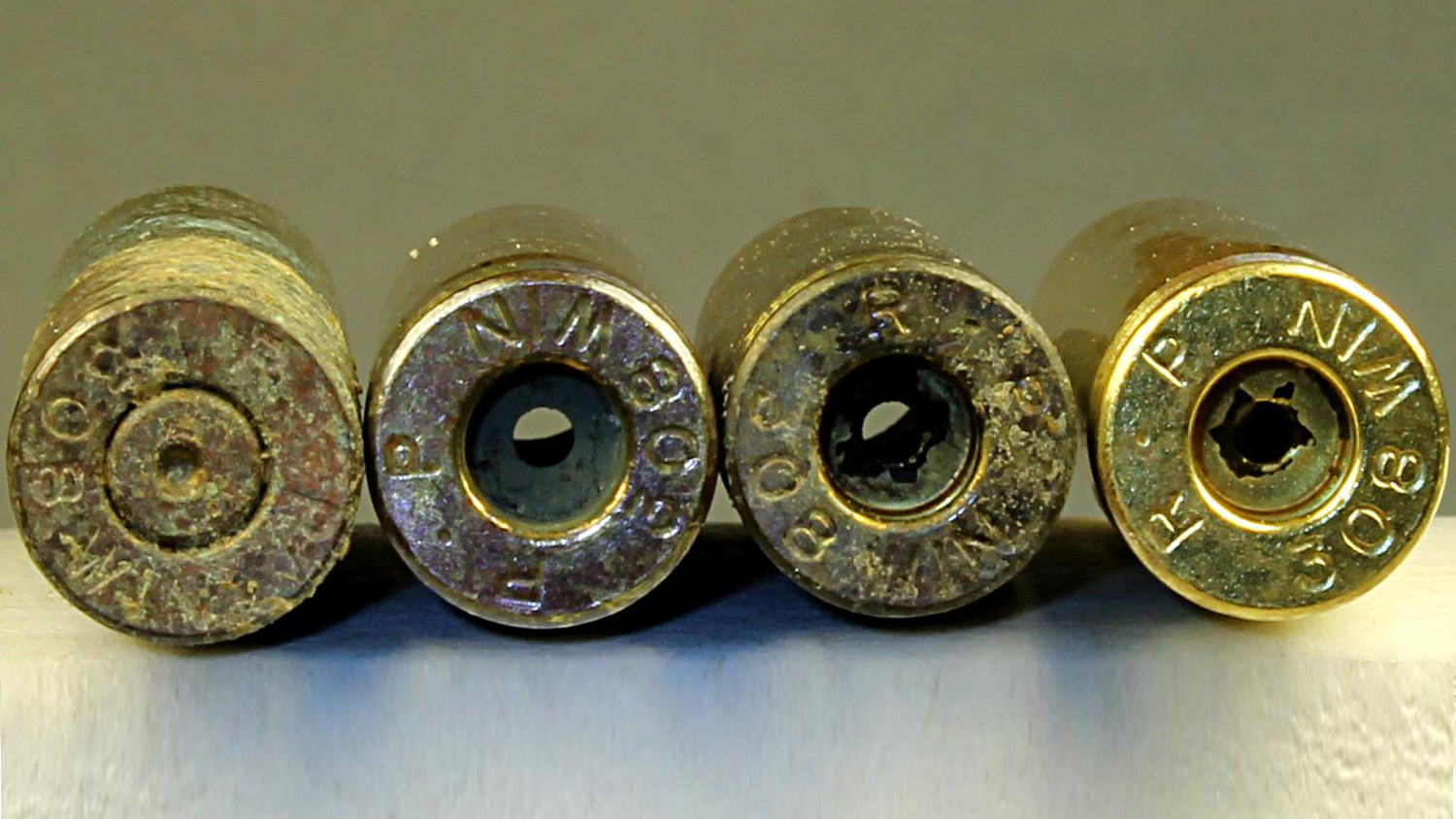
Ultrasonics are the most hassle-free regarding prep, cleanup and time consumption. The smallest ultrasonic cleaners start at about $100; cleaning solution costs about $10 per quart and makes roughly 32 batches of reusable wet solution when mixed 40:1 with water. A second solution allows cleaning of steel gun parts. Negatives: doesn’t polish brass, and doesn’t satisfactorily clean primer pockets.
Retail for the rotary tumbler/stainless steel pin systems is in the $200 neighborhood, with cleaning solution running about the same as for ultrasonic solution. This system alone, though a more expensive start-up, takes less time than dry media, more time than ultrasonics, and is the only one that really cleans primer pockets and makes cases look shiny new inside and out. Winner.













